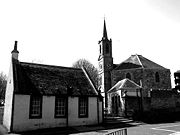
Dreghorn
Encyclopedia

North Ayrshire
North Ayrshire is one of 32 council areas in Scotland with a population of roughly 136,000 people. It is located in the south-west region of Scotland, and borders the areas of Inverclyde to the north, Renfrewshire to the north-east and East Ayrshire and South Ayrshire to the East and South...
, Scotland
Scotland
Scotland is a country that is part of the United Kingdom. Occupying the northern third of the island of Great Britain, it shares a border with England to the south and is bounded by the North Sea to the east, the Atlantic Ocean to the north and west, and the North Channel and Irish Sea to the...
. This parish comprehends the old parishes of Dreghorn and Pearston, which were united in 1668. The whole of the parish was historically the property of the De Morvilles, who were Constables of Scotland and Lords of Cunninghame.
History
Dreghorn is the birthplace of John Boyd DunlopJohn Boyd Dunlop
John Boyd Dunlop was a Scottish inventor. He was one of the founders of the rubber company that bore his name, Dunlop Pneumatic Tyre Company....
, inventor of the pneumatic tyre Dreghorn is believed to be Britain's oldest continuously inhabited village after the remains of an ancient settlement were uncovered by builders. Including the remnants of a 5,500-year-old well (one of only five to be found in Scotland) dating back to around 3500BC. Although other neolithic villages have been abandoned in Scotland, e.g. Skara Brae
Skara Brae
Skara Brae is a large stone-built Neolithic settlement, located on the Bay of Skaill on the west coast of Mainland, Orkney, Scotland. It consists of ten clustered houses, and was occupied from roughly 3180 BCE–2500 BCE...
, Dreghorn is thought to be the only village in Britain with a continual unbroken residence During the development of new housing, a large prehistoric site was discovered to the North of the current Main Street, suggesting that there has been a settlement in Dreghorn for at least 5000 years making it the oldest continuously inhabited village in Britain.
The name Dreghorn may derive from hunting terminology and speaks a little bit about the character of the typical Dreghorn hunter. After a good long hunting session would follow a good long drinking session, where they would fill their hunting horns with ale and drink even the dregs! Another theory is that it's an old Scots name meaning 'farm at the bog', or as in early charters, the name was written Dregern; and it probably derived from the British Tre-quern, which signifies the town or habitation by the swamp, or by the alder-trees.
Maid Morville
Maid Morvilles moundPerceton
Perceton is a medieval settlement and estate in North Ayrshire, Scotland, near the town of Irvine. The old church in Perceton is one of the oldest buildings in the Irvine district...
was located to the left of the bridge over the Irvine, commemorating the tragic drowning of a member of this family who were the overlords of the baillerie of Cunninghame. It was destroyed by the earthworks of the expressway. A 'Maid Morville Avenue' still exists to commemorate the event. Locally the mound was known as 'Marble Hill', a corruption of 'Morville's Hill'. There is also a 'Marble Avenue' nearby.
Train Station
Dreghorn StationDreghorn railway station
Dreghorn railway station was a railway station serving the village of Dreghorn, North Ayrshire, Scotland. The station was originally part of the Glasgow, Paisley, Kilmarnock and Ayr Railway.- History :...
, at the foot of Station Brae by the River Annick, closed in 1964 and carried trains between Irvine and Kilmarnock. The railway is now a public footpath and woodland.
The Church of Scotland

Perceton
Perceton is a medieval settlement and estate in North Ayrshire, Scotland, near the town of Irvine. The old church in Perceton is one of the oldest buildings in the Irvine district...
). It is built in the shape of an octagon and is often referred to the 'Thrup'ny Bit' after pre-decimal three penny coin.. The building, completed in 1780, was sponsored by on of the Earls of Eglinton who brought the idea for the design back from the Continent of Europe. He and his family are buried in the church's graveyard. The session house at the gate of the church was previously the church's mortuary. St. Michael's church in Teignmouth
Teignmouth
Teignmouth is a town and civil parish in Teignbridge in the English county of Devon, situated on the north bank of the estuary mouth of the River Teign about 14 miles south of Exeter. It has a population of 14,413. In 1690, it was the last place in England to be invaded by a foreign power...
, South Devon is another example of this rare church design.
There were at least two other Christian places of worship on this site, and at the uniting of the Parishes of Dreghorn and Perceton, the church owned the land surrounding the church (called a glebe
Glebe
Glebe Glebe Glebe (also known as Church furlong or parson's closes is an area of land within a manor and parish used to support a parish priest.-Medieval origins:...
). A current circular cul-de-sac called The Glebe commemorates this fact.
The second Church of Scotland building (Perceton and Dreghorn Parish Church), initially Perceton and Dreghorn Free Church was formed soon after the Disruption. With the liberal assistance of Mr. Muir Macredie of Perceton, church and manse were built near his house, before February 1844, but was demolished and shipped to Japan after the formation of the new Dreghorn and Springside Parish which united Dreghorn and Perceton Parish and Perceton and Dreghorn Parish. The Muir Hall, built closer to the centre of Dreghorn but now demolished, were the church halls.
Congregational Church
Opposite the village's primary school, stood the Dreghorn Congregational ChurchCongregational church
Congregational churches are Protestant Christian churches practicing Congregationalist church governance, in which each congregation independently and autonomously runs its own affairs....
.

